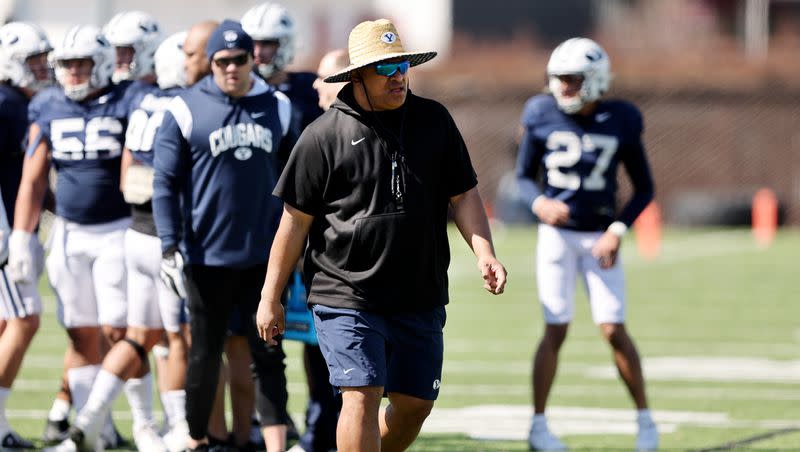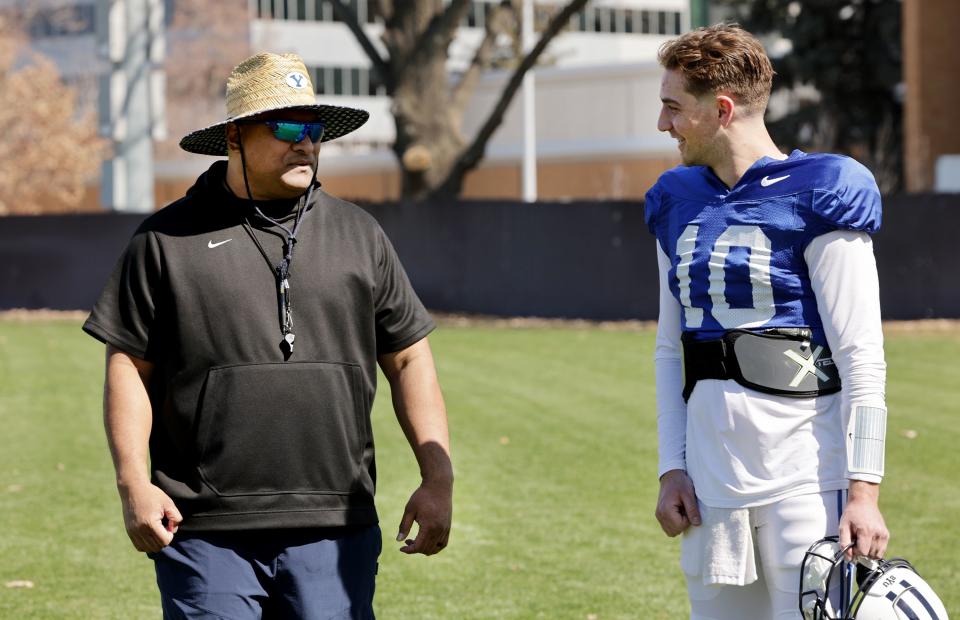Kalani Sitake explains BYU’s approach to NIL

Paying college players has been going on for ages and now it is legal.
But that doesn’t make it easy to swallow for a lot of folks in college sports.
BYU athletic director Tom Holmoe remembers his playing days when he appeared on some obscure radio station as a player and afterward, a producer handed him a coupon for a free meal, something they do for all their guests. Holmoe had reservations about accepting such a gesture.
“Is that legal? Can they do that?” Holmoe wondered.
Nowadays that’s routine. It’s called NIL (name, image, likeness), and athletes are permitted by the NCAA to receive compensation anytime athletes want to use their celebrity for a promotion or for marketing purposes, or even just appearing on radio or TV.
In fact, we see posters, billboards and TV advertisements all over Utah where college stars are used as marketeers and they are compensated for their work.
But this still rubs many college administrators the wrong way.
Texas A&M athletes are benefitting handsomely from #NIL.
From Aug 1, 2022 to June 11, 2023, Aggie athletes received $8.55 million, and that's just from the deals properly disclosed to the school.
Female athletes took home $134k of that amount. Hopefully, that improves.…— Darren Heitner (@DarrenHeitner) July 4, 2023
On June 26, speaking briefly before a media golf event at Cedar Hills, Holmoe said he’d met plenty of his peers in the business who are having a very hard time with all of it. And they’re not old-school fogeys. They’re young career college administrators.
“They are having a very hard time,” said Holmoe.
NCAA rules prohibit coaches from dangling NIL deals in front of recruits to get them to sign. That is called pay-to-play and it is forbidden. Instead, off-campus entities, businesses and collectives are the agents who can make and set up opportunities for student-athletes and they are supposed to actually do something for the money.
Kalani Sitake and Kyle Whittingham are definitely among the coaches around the country who are wary of NIL money floating around their programs. It brings a feeling of entitlement and there’s enough of that without NIL that coaches need to break down, spit out and manage when high school stars enter a program.
Related
Chicken Little or reality? Why college sports must put some restrictions on NIL
Clark Phillips III’s sweet new ride is among the spoils NIL is bringing Ute athletes
Sitake said both he and Whittingham have discussed the challenges and how best to deal with NIL.
Many college recruiters say one of the first things many prospects ask about is how much NIL money is in store for them.
It’s getting to be a trend of a new generation of players in a new day and age.
“I’ve heard about it, everyone has heard stories about it,” said Sitake, “But for us, we’re going to move differently and probably slower than most people are going to. I want to keep the focus away from money. I want us to do things as a team together as much as possible, to have our entire team benefit as much as possible.
“It’s still a work in progress, but I’m always about getting guys what they deserve and all they can to move their lives forward. We have to do it the right way, we represent the church (The Church of Jesus Christ of Latter-day Saints) as an institution so we need to keep aligned in the things we are looking at.”
Sitake said he has heard of athletes asking about NIL right off the bat when approached.
“But the athletes we are bringing in for official visits, that isn’t the focus for them. I think they are more interested in education and opportunities to experience campus life, be a part of the football program and personal growth, and if there are NIL opportunities that come, they will come.”
The NCAA's NIL rule doesn't limit an athlete's ability to profit off his/her name image or likeness. It simply states that NIL deals cannot be offered in the recruiting process. After they sign with a school such deals are not restricted by the NCAA. https://t.co/nrNe6r9CW4
— Mike Irwin (@MikeIrwinPTN) July 6, 2023
Sitake said the trouble with players on a college football team that are being paid a lot of money when they come is exactly what many feared would happen to team chemistry.
“You have athletes who came years ago, worked hard, paid their dues in the weight room and on the field and then a guy comes in and is making a lot of NIL money and they say ‘What about me?’”
That can be very disruptive to a team.
One of the highest-paid players in most college programs these days is quarterback. You see that at USC, Oklahoma, all over the Big Ten, Pac-12, Big 12, SEC and ACC. Last year at Utah and BYU, both Jaren Hall and Cam Rising were making decent NIL money — that is expected for both veterans and many times incoming QB recruits.
Related
‘A lifesaver for players’: Who is behind the BYU NIL collective CougConnect?
Utah football gets boost from Crimson Collective to ‘supercharge’ NIL, recruiting efforts
It is unique this year that BYU signed USC/Pitt quarterback Kedon Slovis, who will be at BYU for just one season, and he decided to enroll when he didn’t have any NIL money offered. He just wanted to be in the program, have a chance to be in an offense he liked, and be around teammates and a school he decided would be a fun experience.
Since Slovis signed, surely he has encountered NIL opportunities this past spring and he will certainly gain more this summer and fall as the season progresses, but he didn’t come to BYU to get paid, according to Sitake.
It’s a whole new world, this NIL quandary.
Athletic directors and coaches across the land are trying to get a handle on it. And after its initial ruling, which opened up a Wild, Wild West kind of war in recruiting, the NCAA is trying to reestablish a little more control and guidelines.
Regardless of how NIL is viewed or handled, it is the new normal. All Utah’s college sports programs are knee-deep in it right now. It’s only going to be more of a factor in months to come.


